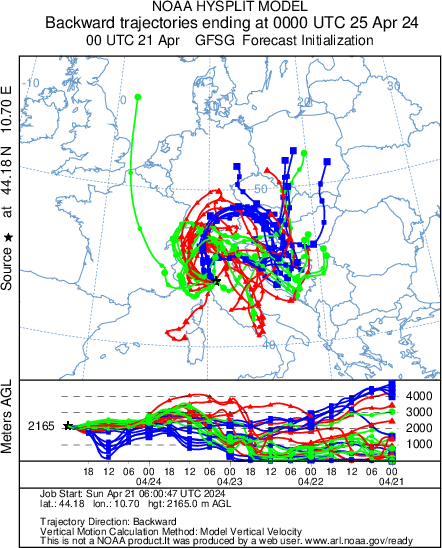Aerosol scattering coefficient
Starting date: 8-5-2007
Status: Running
Instrumentation and calibration: A M9003 integrating nephelometer (ECOTECH) measures the aerosol scattering coefficient at 525 nm since May 2007. The measured values are automatically adjusted to standard temperature and pressure conditions (0°C; 1000 hPa). Air is sampled trough a TSP inlet, heated in order to evaporate cloud droplets; moreover, an additional heater on the measurement cell eliminates the effects of humidity particle growth on scattering behaviour. A calibration on site with low span gas (filtered air) and high span gas (filtered carbon dioxide) is performed every 3 months. Typically, the instrument is operated with an internal averaging time of 1 minute. M9003 nephelometer participated to the 1st NA4 Aethalometer-Nephelometer Intercomparison (Leipzig, Germany - March 2007) in the framework of EUSAAR project. Project affiliation (s) Present: SHARE, GAW-WMO, EUSAAR, AEROCLOUDS
Related research programmes
- Tropospheric background condition
- Aerosol properties
- Long-range transport
- Saharan dust transport
Why is this research important? Ambient aerosol particles play an important role in the overall energy balance of the atmosphere by scattering and absorbing incoming and outgoing solar and terrestrial radiation (the “direct effect”) and by modifying microphysical properties of clouds (the “indirect effects”) through their role as cloud condensation nuclei. The determination of the direct effects of aerosols on the earth radiation balance requires quantitative information on the optical properties of atmospheric aerosols. Through scattering and absorption of solar radiation, aerosols can cool or warm the Earth’s atmosphere and alter the climate. Measuring the scattering variability is a try to understand how the aerosol optical properties vary with time, season and long range transport of pollutants. Moreover, information on the extinction coefficient, which is related to visibility in the atmosphere, is also an important parameter in global climate models. In general, the interaction of a scattering and absorbing aerosol with the radiative flux at various levels in the atmosphere could change the albedo of the earth and the temperature profile of the atmosphere: pure scattering will increase the albedo of the earth and reduce the amount of solar radiation incident on the earth, causing a net cooling of the earth-atmosphere system, while absorption of solar and terrestrial radiation by particles could cause a greenhouse effect near the earth's surface. Uncertainty on the aerosol effect on global radiative forcing is still very high, as also reported by the Intergovernmental Panel on Climate Change. The objective of this measurement program is to determine the variability of aerosol scattering coefficient at ICO-OV in relation to air mass origins, and to derive information to describe the most common conditions observed at ICO-OV. In addition, observed values of the scattering coefficient, combined with absorption, can be used to estimate the direct aerosol radiative forcing for the region.
Quick look The seasonal scattering coefficient time series at ICO-OV show a seasonal cycle with the highest values in spring–summer and the lowest value in autumn–winter. Except in winter, the scattering coefficient shows a clear diurnal variation with high values during day-time and background conditions during night.
Organization (s): ISAC-CNR Via Gobetti 101, I-40129, Bologna www.isac.cnr.it
Contact persons: Dr. Angela Marinoni e-mail: a.marinoni [at] isac.cnr.it, phone: +39 051 6399597
Where can I find the data? World Data Centre for Aerosol (WDCA hosted by EBAS at NILU) or by direct request to: a.marinoni [at] isac.cnr.it



